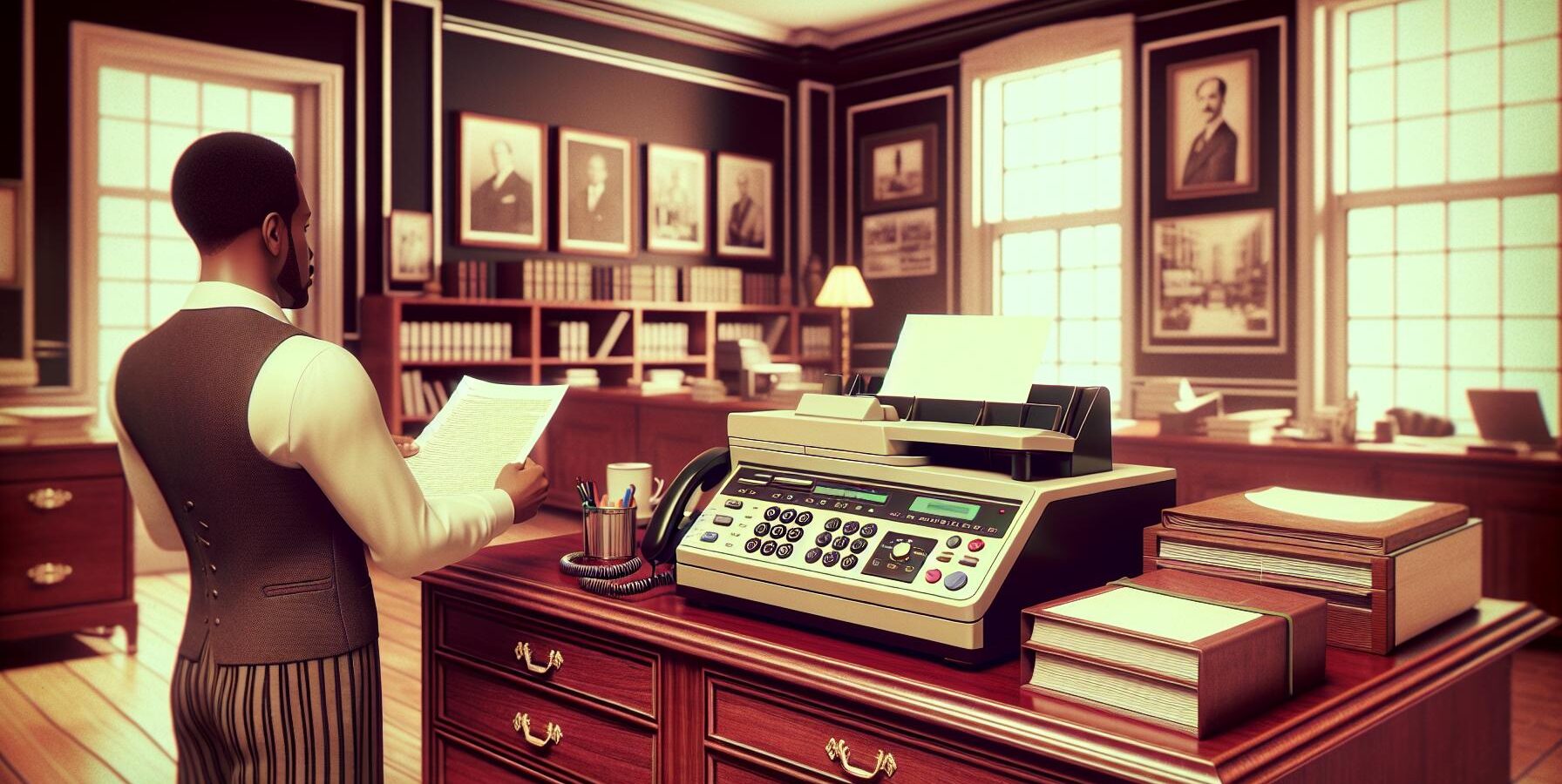In today’s digital age, the humble fax machine near me might seem like a relic of the past, but it still holds significant value for many businesses and individuals. Whether it’s for sending important documents securely or dealing with institutions that require fax communications, finding a reliable fax machine near you can be a necessity.
Locating a fax machine nearby doesn’t have to be a daunting task. Various places, from office supply stores to local libraries, offer fax services. This guide will help you navigate the best options to ensure you can send or receive faxes efficiently and conveniently.
What To Look For In A Fax Machine
Selecting the right fax machine involves evaluating several critical aspects. These include key features, reliability, speed, and ease of use.
Key Features
Fax machines offer various key features essential for efficiency. Look for machines with:
- High Resolution: Offers clear, sharp text and image clarity.
- Multiple Connectivity Options: Supports both phone line and internet faxing.
- Large Memory: Stores multiple pages, enabling bulk faxing.
- Energy Efficiency: Reduces power consumption, lowering costs.
Reliability And Speed
Reliability and speed are crucial for timely, error-free transmissions. Assess the following:
- Transmission Speed: Faster machines often send faxes within seconds, improving workflow.
- Error Correction: Reduces transmission errors, ensuring complete data transfer.
- Service Availability: Models from reputable brands tend to offer better support and reliability.
- User-Friendly Interface: Intuitive panels and displays simplify navigation.
- Automatic Document Feeder: Allows multi-page faxing without manual input for each page.
- Setup and Maintenance: Easy installation and minimal maintenance requirements streamline operations.
Popular Fax Machine Brands
Selecting a reliable fax machine involves knowing the top brands in the market. These manufacturers offer a range of models catering to different needs.
Brother
Brother is renowned for its high-quality fax machines. Their models often feature intuitive interfaces and robust performance. Many Brother fax machines support both laser and inkjet printing, providing versatility. Key models include the Brother IntelliFax series, which offers features like high-speed transmission, large memory, and error correction.
HP
HP provides reliable and multifunctional fax machines. Their models often integrate with printing and scanning functionalities, making them ideal for businesses seeking all-in-one solutions. The HP OfficeJet series, for example, incorporates faxing, scanning, and copying in a single device. HP’s machines are known for their durability and advanced security features.
Canon
Canon’s fax machines are known for their high-resolution faxing capabilities. Canon’s models often include energy-efficient technologies and multiple connectivity options like Wi-Fi and Ethernet. The Canon FAXPHONE series offers features like automatic document feeders and laser printing. Canon also ensures user-friendly interfaces, making their machines easy to operate and maintain.
Epson
Epson stands out with its innovative fax machine designs, focusing on cost-efficiency and high performance. Epson’s WorkForce series not only supports faxing but also high-quality printing and scanning. Key features include large memory capacity, fast transmission speeds, and eco-friendly technology. Epson’s machines cater to both small businesses and larger enterprises, offering solutions tailored to varied requirements.
Here’s a quick comparison of key features across these brands:
| Brand | Key Models | Key Features |
|---|---|---|
| Brother | IntelliFax Series | High-speed, large memory |
| HP | OfficeJet Series | Multifunctional, durable, secure |
| Canon | FAXPHONE Series | High-resolution, energy-efficient |
| Epson | WorkForce Series | Cost-efficient, eco-friendly |
Choosing among these top brands ensures reliability and advanced features to meet faxing needs efficiently.
Ways To Locate A Fax Machine Near You
Finding a fax machine nearby can be essential for secure document transmission. Here are effective ways to locate one.
Google Maps
Google Maps helps locate nearby fax machines efficiently. Start by opening the app or visiting the website. Enter “fax machine near me” in the search bar. The map displays nearby locations offering fax services, such as office supply stores and libraries, with contact details and operational hours. Reviews can aid in selecting a reliable provider.
Yelp
Yelp provides user reviews and ratings for businesses, including those offering fax services. Search for “fax machine near me” on the Yelp website or app. Filter results by distance, rating, or open hours to find the most suitable option. Reading reviews can provide insight into the quality of service and any potential issues.
Local Business Directories
Local business directories list various service providers. Websites like Yellow Pages or local community boards often have sections for office services. Search for fax services using keywords like “fax machine” or “document services.” Contact information and hours of operation are usually listed, making it easy to find a nearby fax machine.
Cost Considerations
When finding a fax machine nearby, cost considerations play a crucial role. Users must weigh the financial implications of various options carefully.
Purchase vs. Rental
Acquiring a fax machine outright offers long-term savings. Consumers and businesses, however, must budget for the initial investment, which can range from $100 for basic models to over $500 for advanced multi-functional devices. On the other hand, renting can be more feasible for short-term needs or infrequent use. Rental costs vary but typically range from $10 to $50 per month, depending on the machine’s features and capabilities.
Maintenance And Supplies
Beyond the initial expense, ongoing maintenance and supplies affect the overall cost of owning or renting a fax machine. Regular maintenance extends the machine’s lifespan and ensures reliable performance. Maintenance costs vary, generally falling between $50 and $150 annually. Supply costs, including paper and toner, should also be considered. Toner cartridges usually cost between $20 and $100, depending on the machine type and the brand, while paper expenses remain relatively low but consistent.
Tips For Secure Faxing
Securing fax transmissions is crucial to protect sensitive information from unauthorized access.
Data Encryption
Encryption encodes data to prevent unauthorized access. Use fax machines with built-in encryption to ensure transmitted documents stay confidential. Look for models that use Advanced Encryption Standard (AES), which is widely recognized for its security.
User Authentication
User authentication verifies the identity of the individual sending or receiving faxes. Implement authentication measures like personal identification numbers (PINs) or biometric verification. This ensures that only authorized personnel can send or receive sensitive documents, reducing the risk of data breaches.
Discover the Power of BlueNotary:
Integrate your Business, Title Company, or Law Firm to Satisfy your Customers and Decrease Turnaround
Get a document Notarized/Sign-up
Join the Free Notary Training Facebook Group
Conclusion
Fax machines remain a vital tool for secure document transmission in today’s digital landscape. Locating a reliable fax machine nearby is crucial for both individuals and businesses. By considering key features like high resolution, multiple connectivity options, and energy efficiency, users can select the right fax machine to meet their needs.
Popular brands like Brother, HP, Canon, and Epson offer a range of models tailored to different requirements. Tools like Google Maps, Yelp, and local business directories can help users find nearby fax services efficiently. Cost considerations, including purchasing versus renting and maintenance expenses, are essential for informed decision-making.
Security is paramount, and investing in fax machines with data encryption and user authentication measures ensures the protection of sensitive information. By following these guidelines, users can navigate the complexities of faxing in the modern world with confidence and ease.
Frequently Asked Questions
Why are fax machines still relevant today?
Fax machines remain essential for secure document transmission and are often required for communication with certain institutions that prefer or mandate their use.
Where can I find a reliable fax machine nearby?
You can locate fax services at office supply stores, local libraries, or by using Google Maps, Yelp, and local business directories like Yellow Pages.
What should I consider when selecting a fax machine?
Key features to consider include high resolution, multiple connectivity options, large memory, energy efficiency, reliability, speed, user-friendly interface, automatic document feeders, and ease of setup and maintenance.
Which are the top fax machine brands?
Popular brands include Brother, HP, Canon, and Epson. Each offers a range of models tailored to different needs, highlighting various strengths such as high quality, multifunctionality, high resolution, and eco-friendliness.
How can I locate a nearby fax service efficiently?
Use online tools like Google Maps for locations and operational hours, Yelp for user reviews and ratings, and local business directories like Yellow Pages to find contact information and hours of operation.
What are the cost considerations when finding a fax machine?
Consider whether to purchase or rent a fax machine. Buying offers long-term savings, while renting is feasible for short-term needs. Factor in maintenance and supply costs for toner and paper.
How can I ensure secure faxing to protect sensitive information?
Use fax machines with built-in encryption (preferably Advanced Encryption Standard) and user authentication measures like PINs or biometric verification to protect against unauthorized access.








